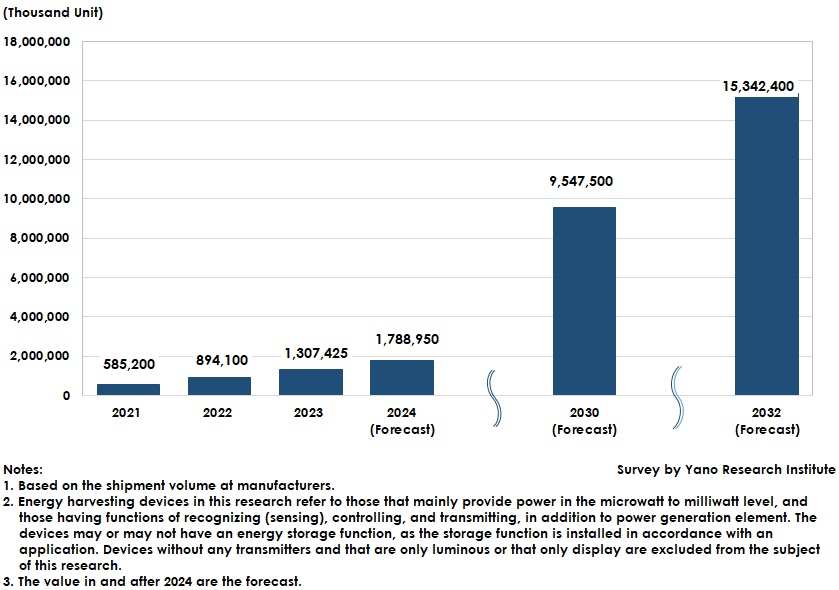No.3575
Global Energy Harvesting Device Market: Key Research Findings 2024
Any Sites Can be Promising! Ingenious Operations Can Improve Added Values of Existing Products
Yano Research Institute (the President, Takashi Mizukoshi) has surveyed the global market of energy harvesting devices and has found out the status and future perspectives.

Market Overview
An energy harvesting device, or an energy harvester captures or harvests minute energy from ambient environment and converts into usable electric power, and is one means of securing electricity. The energy sources from which to harvest are mainly light and vibration, but there are various other sources. Lately, energy harvesting devices gather attention as the power source that dispense with battery exchanges, which can meet demand for saving labor of IoT device battery exchanges. With growing consciousness to achieve the sustainable society worldwide, expectations are high for these devices as the means to alleviate environmental impacts.
The global energy harvesting device market for 2023 by shipment volume at manufacturers has been estimated at 1,307,425 thousand units. Battery regulations in Europe and guidelines in each county have paved the way for the environment to introduce energy harvesting. Despite increased adoptions and implementations of energy harvesting devices, there still is enough room to widespread furthermore. Therefore, the shipment volume is projected to increase to 1,788,950 thousand units in 2024.
Noteworthy Topics
Expectation for New Energy Sources and Applications that Appear One after Another
While conventional energy harvesting devices developed from principles have already been launched in the market, new power generation sources have been developed one after another.
In 2023 an energy harvesting module that uses energy from electromagnetic wave noise has been developed. It applies technology that has been cultivated in tuner development processes to generate power from electromagnetic wave noise in a highly efficient manner. This technology, for example, can use electromagnetic wave noise constantly generated by robots at factories, monitors and lighting at offices, monitors, TVs, refrigerators at stores and households, to provide stable power supply needed for low-power consuming IoT sensors and communications equipment. It is expected as one of the solutions to the power source issue that has become gradually apparent for ever-increasing IoT devices.
For botanical power generation kits sold since 2021, a new model has been released in 2023. Botanical power generation has been developed as a new aspect of energy harvesting technology. The kit consists of a magnesium plate, a piece of bincho charcoal (high-grade oak charcoal), LED light, a control substrate, and a cable. While the values of voltage and electric current differ by the environment of where the kit is installed, voltage of power generated per kit is between 0.7 and 1.2V, the voltage after boost is between 1.6 and 3V, the electric current between 0.1 and 20mA. The mechanism of power generation is the technology that efficiently collects the energy generated from sugar and micro-organism in botanical roots and the energy generated by circulatory effect from aquatic plants and micro-organism in the water into an electrode. Power can be generated just by sticking the electrode into soil or water, as long as the soil has a botanical plant growing despite shortage of sunlight, and the water has aquatic plants and micro-organism growing. Botanical power generation is attracting attention as a new natural energy source that does not disrupt the environment.
Future Outlook
The global energy harvesting device market by shipment value at manufacturers is projected to expand to 15,342,400 thousand units by 2032. Demonstrations for energy harvesting device implementations are conducted, as an EU battery regulation is approved and some guidelines (regulations) in each country are in place. In Japan, ‘Requirements for IoT systems for schools using energy harvesting devices and their development guidelines’ established as a standard by the Japanese Standards Association (JSA) in April 2024 is regarded to drive the market growth. In addition, better performance of each component (elements of power generation, control, power storage, etc.) may bring about improvement in energy harvesting devices themselves, which can expect deployments to the realm that has been difficult.
Because energy harvesting devices can last permanently if the operations including maintenance and management are done stably, and because they need no exchanges of primary batteries, they are projected to be adopted in various applications as a power source that reduces environmental burdens.
Research Outline
2.Research Object: Manufacturers of energy harvesting devices (mainly those at microwatts to milliwatts level), related universities and R&D institutions, etc.
3.Research Methogology: Face-to-face interviews (including online) by expert researchers, survey via telephone/email, and literature research
Energy Harvesting Devices
An energy harvesting device, or an energy harvester captures or harvests minute energy from ambient environment and converts into usable electric power, and is one means of securing electricity.
Energy harvesting devices in this research refer to those that mainly provide power in the microwatt to milliwatt level, and those having functions of recognizing (sensing), controlling, and transmitting, in addition to power generation element. The devices may or may not have an energy storage function, as the storage function is installed in accordance with an application. Devices without any transmitters and that are only luminous or those that only display are excluded from the subject of this research. The market size is calculated based on the shipment volume at manufacturers worldwide.
<Products and Services in the Market>
Devices that have functions of recognizing (sensing), controlling, and transmitting, in addition to power generation element.
Published Report
Contact Us
The copyright and all other rights pertaining to this report belong to Yano Research Institute.
Please contact our PR team when quoting the report contents for the purpose other than media coverage.
Depending on the purpose of using our report, we may ask you to present your sentences for confirmation beforehand.